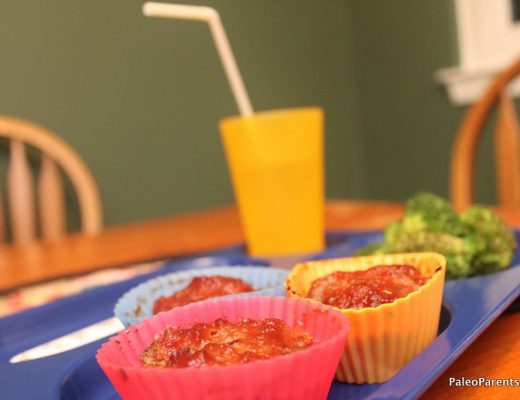Today marks the first day of a new tradition on the blog. Instead of reviewing all the latest paleo books coming out near-weekly, we will now only be sharing about the greatest books via guest posts from the authors themselves! As luck would have it, there is no better way to break in this new tradition with one of the Paleo Parents very good friends The Paleo Mom. Sarah and I have been like paleo-family since the start of our podcast together, The Paleo View.

Sarah and I recently presented this presentation at AHS this year!
It was through this friendship that Sarah talked me through following The Paleo Approach well before the book was even out. In my review of The Paleo Approach, I discussed in detail how the protocol helped heal my gut and recover my health. I still follow a modified Autoimmune Protocol and manage my autoimmune diseases through eating nutrient dense foods and lifestyle factors, such as sleep and stress management. Which is why it’s such a full circle moment that the review for this book be the first of many to come; because managing stress and the amount of work that we do on the blog is one of the things I am really focused on right now in order to maintain her health!
As I note on the upcoming The Paleo View episode about The Paleo Approach Cookbook, this is the book I wish I had years ago when I started following Sarah’s The Paleo Approach Autoimmune Protocol! After being paleo for years, I was clueless about how to go about successfully eating off of what felt like such a limiting list of foods. There were several days that involved tears and temper tantrums. But now with The Paleo Approach Cookbook none of that is necessary anymore! Sarah comes up with inventive, creative, and utterly delicious recipes using ingredients I never would have thought to work for the uses she puts them to (for example, using vegetables as a flour base for baked goods)!

Among everything else, I’m honored to be a part of The Paleo Approach Cookbook. From the quote on the back of the book, to a success story Sarah can reference, and to now being able to contribute a recipe that might help people be less frustrated with the lack of snacking options – it is an honor to have been a part of this book. I can’t call it a cookbook – even though there are over 200 recipes – to me this is really a guidebook. It is the simple, easy to understand guide for people who want to follow the plan for all the science laid out in The Paleo Approach. The “cookbook” still explains how and why, and if you want more info the The Paleo Approach will make an excellent reference book to read more details on the science!
Ok, see, old habits are hard to break. This isn’t my review post – it’s a guest post by Sarah with a recipe I happen to know is AWESOME – so don’t miss the RECIPE at the bottom of the page!
♥♥♥
Not all the recipes from The Paleo Approach Cookbook have long involved histories. But my recipe for Pork Rinds does have a backstory, and it’s one that features the influence of Paleo Parents and Beyond Bacon. So, I can’t think of any better way to celebrate the launch of my new book than with sharing this story and the recipe here!
I decided early on in the development of The Paleo Approach Cookbook that I wanted to include a recipe for pork rinds. Skin (which is what pork rinds are made from) is collagen-rich, so it’s very similar to broth in its anti-inflammatory and healing properties. Pork rinds are also one of few crunchy salty snacks that are Autoimmune Protocol-friendly. I’m a firm believer that we should still be able to eat tasty food, even while following a restricted diet to heal our bodies, and being able to indulge in the deliciousness that is pork rinds is as much about quality of life as it is about getting more glycine into our diets.
I also had half a hog in my freezer, which I had recently purchased from a local farmer inspired by chatting with Stacy every week about the recipes she and Matt were creating for Beyond Bacon. And I needed to do something with that 5 pound bag of pork skin!!! Pork rinds were one of the very first recipes I worked on developing for The Paleo Approach Cookbook. Actually, I started working on this recipe even before I knew I was writing two books!
Aside: When I first embarked on this journey that eventually became the New York Times Bestseller The Paleo Approach and its releasing-TODAY companion cookbook The Paleo Approach Cookbook, I had intended on writing one everything-in-one-place complete guidebook for using diet and lifestyle to manage autoimmune disease. I envisioned Practical Paleo with a bit more science, a few less meal plans, and all geared towards those with autoimmune and immune diseases. I just underestimated how many pages it would take to describe all the science I wanted to by a factor of about 4 and underestimated the number of recipes I wanted to include by a factor of about 3. Dividing the initial overly ambitious project into two books provided a number of advantages, including giving me more time to perfect recipes for the cookbook.
A quick search of the internet for pork rind recipes yielded two different cooking methods: deep frying and baking. Being ever the fan of simplicity (and at this time, generally intimidated by deep frying), I chose to bake my pork rinds. I looked at about half a dozen recipes, found the average cooking temperature and time, and set about the task of chopping up 5 pounds of pork skin into thin strips.
Baking worked to crisp up the pork rinds, but there was a problem. The thinner skin was a lovely texture, and the fat underneath the skin had turned into crisp-then-melt-in-your-mouth awesomeness. But, the thicker skin was so crunchy that it was near impossible to eat. In fact, my mom visited me around this time, tried one, and then refused to eat any more for fear of breaking a tooth.
I didn’t really know any better. I figured I could put a note in the instructions to only use thin pig skin. In hindsight, that’s not necessarily a very easy thing to source. So, it’s a darned good thing that Matt and Stacy were not intimidated by deep-frying and were there to the rescue!

I travelled to DC to attend the Beyond Bacon release party, which was hosted by Red Apron Butchery. One of the many delectable morsels served was pork rinds: light, fluffy, airy, crisp, melt-in-your-mouth, and tooth-preserving pork rinds. Stacy made an off-hand remark to the effect of “this is what the Curried Cracklin recipe in Beyond Bacon is like“. My thought was something to the effect of “really? geez, I guess it’s back to the drawing board.”
I also thought “I guess I should try out that new countertop deep fryer my husband got me.” When I got home from that trip, I decided to try Matt and Stacy’s recipe. This involved a bit of a learning curve from me and a couple of text messages to Stacy to make sure I was doing it right (I wasn’t, so it’s a good thing I had a direct line to the experts!).
Two things happened. First, I discovered that deep frying even with an inexpensive countertop deep fryer is a completely different experience than doing it in a pot on the stove with an oil thermometer–especially my stove, which is old and incredibly inconsistent when it comes to temperature. It controls temperature by itself so I never accidentally heat up the fat above smoke point, and the screened lid means there’s no fat splatter all over my kitchen. Second, I discovered that every extra minute of time invested into Matt and Stacy’s method of making Pork Rinds was worth it. The result was the magical transformation of a part of the animal that many people throw away to a soul-satisfying and nutrient-dense snack made of pure joy.
But, then it hit me. I wanted to include a recipe for Pork Rinds in The Paleo Approach Cookbook, but I couldn’t just copy the recipe from Beyond Bacon! And I couldn’t improve upon the recipe, except for maybe to include some of the tips I had learned from doing it wrong initially and working with slightly different equipment. Unfortunately for many cookbook authors, there’s ways around plagiarism laws and I knew from seeing other people steal my recipes what could be done to use this recipe and get around those laws–um, but that would be pretty darned unethical! And I’m not that kind of person!

I didn’t make a decision on how I would handle this conundrum until March of this year, when Russ Crandall of The Domestic Man (and author of The Ancestral Table), Stacy and I did a joint signing together in both Alexandria, VA and Philadelphia, PA. We stayed one night at Russ’ home where Russ fed us an amazing meal consisting of a recipe out of The Ancestral Table and a new recipe that he had just perfected, for Autoimmune Protocol-friendly Flatbread. Dang. Now there were two recipes, created by my friends, that were better than the versions I created in my own kitchen. I had been working on a flatbread recipe without any success for months.
It’s fairly common in the e-book world to create books that are collections of many bloggers’ recipes. It’s not that common in print books though. Plus, that’s not what my book was. This is the companion guide to my first book, containing a collection of information and amazing recipes to help people be successful making diet changes to manage autoimmune disease. It took a bit of swallowing my pride to do what I knew would be best for the autoimmune disease community: include two spectacular recipes created by two amazing authors that are not me. Out of 207 recipes, only two are not my own, but they are two that I felt very passionately about including in my book.
I was lucky that both Matt & Stacy and Russ were delighted to give me permission to include their recipes in The Paleo Approach Cookbook. And I feel that the book is an even better resource because of it. I also feel very fortunate to be a member of such a supportive community of bloggers, people who really care about helping people and contributing to the greater conversation about how to optimize health. I owe Stacy, Matt and Russ my thanks for helping to make my book the best it could be.
When I made Pork Rinds the last time to photograph them for The Paleo Approach Cookbook, it just so happened my mom was visiting again (nearly a year and a half had passed between her tasting my original Pork Rind recipe and the new and improved version). My mom’s word were “mmmm, much better” and we proceeded to share an entire bowl.
So, without further adieu, here is a Sneak Peek preview recipe from my new book, The Paleo Approach Cookbook.
I learned how to make light and airy pork rinds from Beyond Bacon by Stacy Toth and Matthew McCarry. Matt and Stacy’s version just can’t be beat, so this recipe is adapted with permission from their Curried Cracklin’s recipe. The toughest thing about making pork rinds is cutting the pork skins into small pieces. Fortunately, this is something that your butcher can do for you. If you are doing it yourself, try using sharp kitchen scissors instead of a knife.
Ingredients
- 2 pounds pork skins, cut into small pieces or strips
- 2 to 4 teaspoons salt
- Lard and palm shortening, for deep-frying
- Dehydrator
- Countertop deep-fryer or heavy-bottomed pot with an oil thermometer
Instructions
- Bring a stockpot full of water to a boil on the stovetop. Add the pork skins and simmer for 10 minutes.
- Remove the skins from the water and place on a kitchen towel or paper towels to drain. Cover with additional paper towels and press to remove any excess water.
- Arrange the pork skins on the racks of a dehydrator. Dehydrate for 6 to 24 hours, depending on your dehydrator, until the skins are rock-hard little bricks.
- When ready, heat a mixture of half lard and half palm shortening to 375°F in a counter-top deep-fryer or heavy-bottomed pot over medium to medium-high heat with a deep-fry thermometer attached to the side. Add enough fat to fill the deep-fryer to the fill line or to have about 2 inches of fat in the pot.
- Fry the pork skins in batches, being careful not to overcrowd, until puffed up, light, and airy (7 to 10 minutes, depending on the size of the pieces). They will float and more than double in size, so put in fewer than you think will fit and err on the side of frying more batches.
- Remove from the deep-fryer and drain on a towel or paper towels. Sprinkle liberally with salt while still warm.
Notes
Tips: If you don’t own a dehydrator, you can also dehydrate the pork skins in your oven at the lowest temperature setting. If the skins have a good lining of fat, it can be hard to gauge whether they are dehydrated enough to fry. If they aren’t puffing up in the fryer for you, they need to be dehydrated longer. The use of palm shortening allows for higher-temperature deep-frying without exceeding the smoke point.
[author] [author_image timthumb=’on’]http://paleoparents.com/wp-content/uploads/2014/08/Sarah-bio-photo-square.jpg[/author_image] [author_info]Sarah Ballantyne, PhD (a.k.a. The Paleo Mom) is the blogger behind the award-winning www.ThePaleoMom.com; cohost of the syndicated top-rated The Paleo View Podcast; and New York Times bestselling author of The Paleo Approach and The Paleo Approach Cookbook.
Connect with Sarah: | Facebook | Instagram | Twitter | Pinterest | Blog | [/author_info] [/author]






